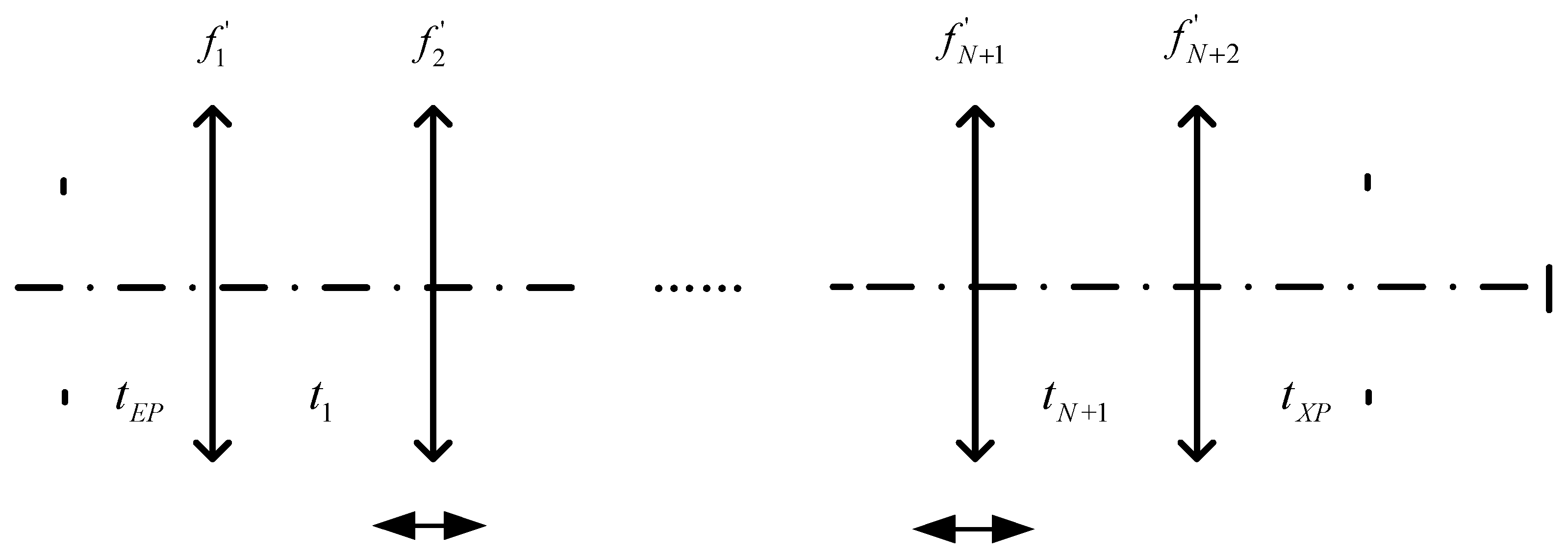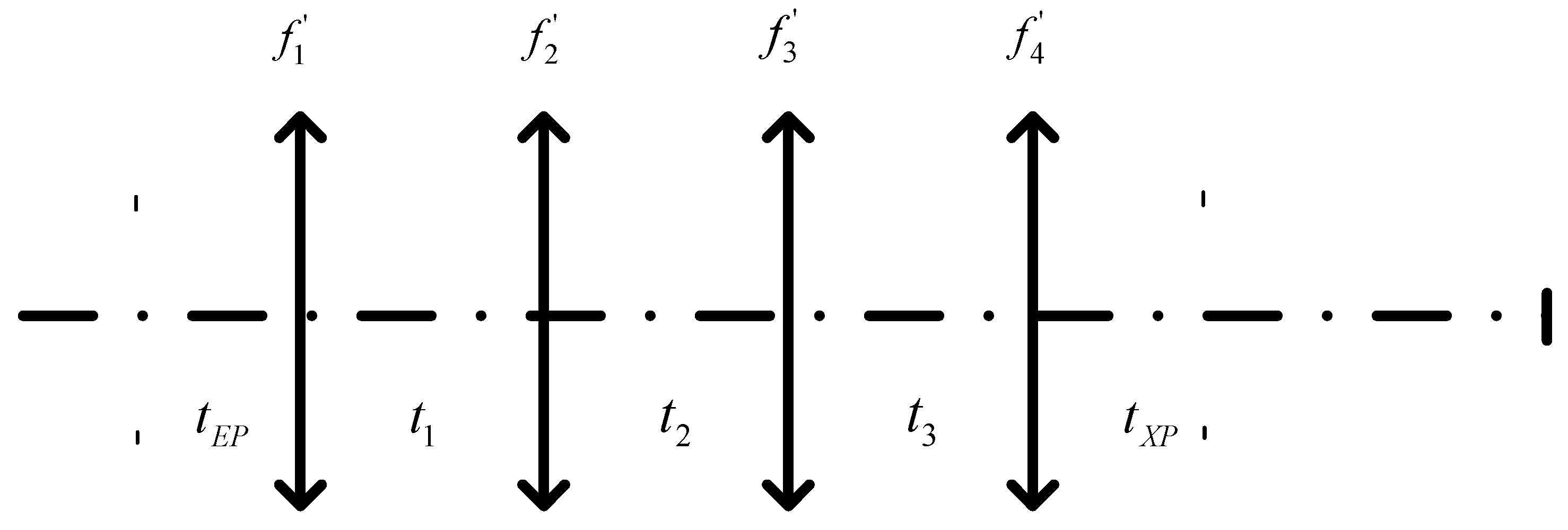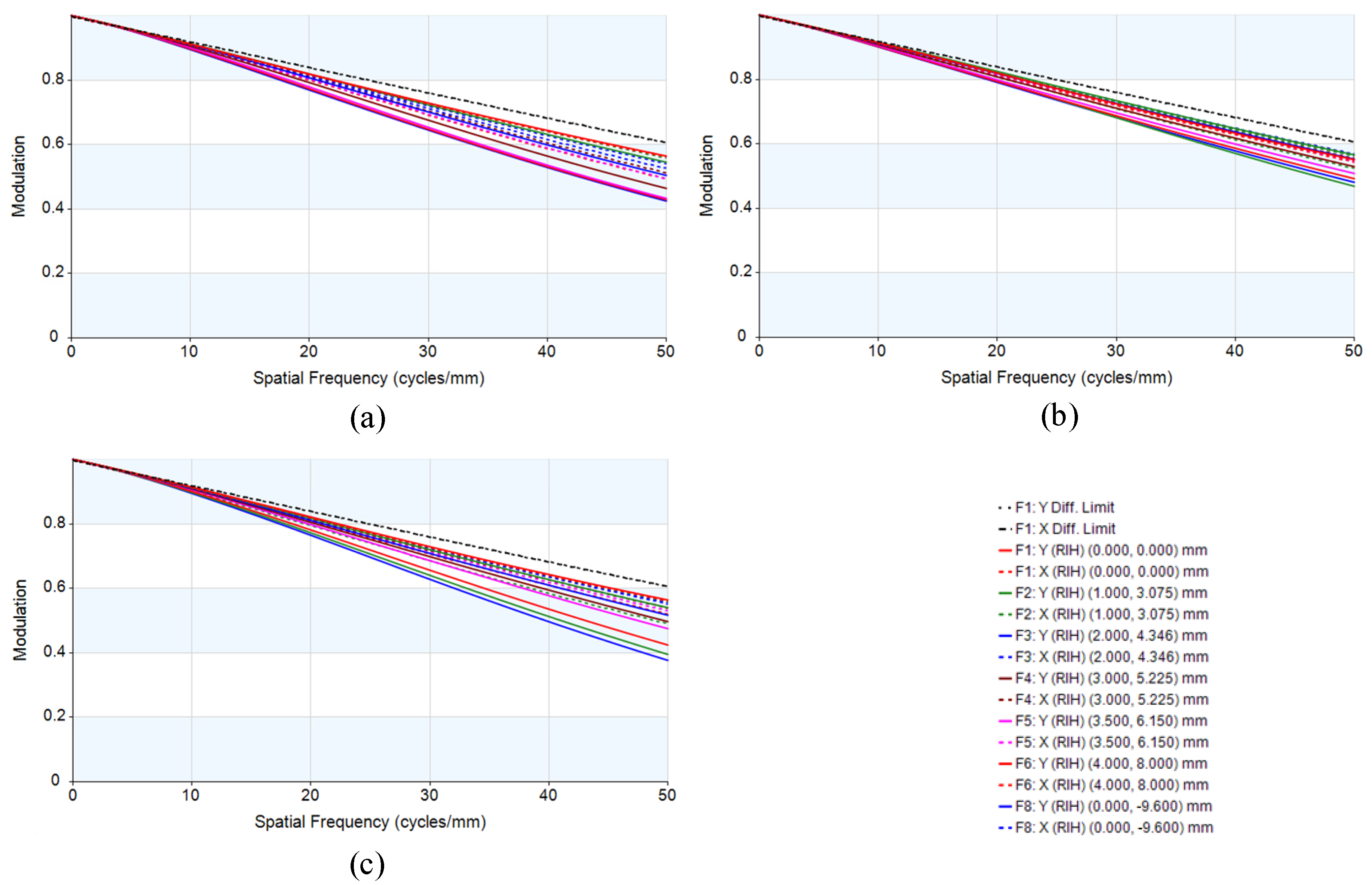Optical Design of a 4× Zoom Lens with a Stable External Entrance Pupil and Internal Stop
Abstract
:1. Introduction
2. Paraxial Design
2.1. Varifocal Differential Equation (VDE)
2.2. Two-Moving Parts Zoom Lens
3. Optical Design
3.1. Specifications
3.2. Design and Optimization Process
3.3. Design Results
4. Performance
4.1. Cam Curve and Pupil Walking
4.2. MTF and Relative Distortion
4.3. Tolerance Analysis
5. Conclusions
Author Contributions
Funding
Institutional Review Board Statement
Informed Consent Statement
Data Availability Statement
Conflicts of Interest
References
- Vizgaitis, J.N. Optical concepts for dual band infrared continuous zoom lenses. In Proceedings of the International Optical Design Conference 2010, Jackson Hole, WY, USA, 9 September 2010. [Google Scholar]
- Akram, M.N.; Asghar, M.H. Step-zoom dual-field-of-view infrared telescope. Appl. Opt. 2003, 42, 2312–2316. [Google Scholar] [CrossRef]
- Khatsevich, T.N.; Volkova, K.D. Stabilization of the exit pupil in an optical zoom sight with variable magnification. J. Opt. Technol. 2017, 84, 605–612. [Google Scholar] [CrossRef]
- Song, W.; Zhao, Y.; Berman, R.; Bodell, S.Y.; Fennig, E.; Ni, Y.; Papa, J.C.; Yang, T.; Yee, A.J.; Moore, D.T.; et al. Optimal power distribution for minimizing pupil walk in a 7.5x afocal zoom lens. In Proceedings of the International Optical Design Conference 2017, Denver, CO, USA, 27 November 2017. [Google Scholar]
- Wooters, G.; Silvertooth, E.W. Optically compensated zoom lens. J. Opt. Soc. Am. 1965, 55, 347–351. [Google Scholar] [CrossRef]
- Hopkins, H.H. 2-Conjugate Zoom Systems. In Optical Instruments and Techniques; Home-Dickson, J., Ed.; Oriel Press: London, UK, 1970; pp. 444–452. [Google Scholar]
- Hopkins, H.H. Zoom Lens System for Maintaining Two Pairs of Conjugate Planes Fixed. U.S. Patent 3619035, 9 November 1971. [Google Scholar]
- Bystricky, K.M.; Yoder, P.R. An improved zoom lens with external entrance pupil. In Proceedings of the Annual Technical Symposium, San Diego, CA, USA, 1 March 1974. [Google Scholar]
- Yeh, M.; Shiue, S.; Lu, M. First-order analysis of a two-conjugate zoom system. Opt. Eng. 1996, 35, 3348–3360. [Google Scholar] [CrossRef]
- Kryszczyński, T. Method to solve any paraxial pupil problems. In Proceedings of the Optical Science, Engineering and Instrumentation, San Diego, CA, USA, 25 September 1997. [Google Scholar]
- Mikš, A.; Novák, J. Three-component double conjugate zoom lens system from tunable focus lenses. Appl. Opt. 2013, 52, 862–865. [Google Scholar] [CrossRef] [PubMed]
- Miks, A.; Novak, J. Paraxial imaging properties of double conjugate zoom lens system composed of three tunable-focus lenses. Opt. Lasers Eng. 2014, 53, 86–89. [Google Scholar] [CrossRef]
- Novák, J.; Novák, P.; Mikš, A. Analysis of double conjugate zoom lens using tunable-focus lenses. In Proceedings of the Current Developments in Lens Design and Optical Engineering, San Diego, CA, USA, 25 September 2014. [Google Scholar]
- Mikš, A.; Novák, J. Method of first-order analysis of a three-element two-conjugate zoom lens. Appl. Opt. 2017, 56, 5301–5306. [Google Scholar] [CrossRef] [PubMed]
- Sarabia, C.M.G.; Castaneda, J.O. Two-conjugate zoom system: The zero-throw advantage. Appl. Opt. 2020, 59, 7099–7102. [Google Scholar] [CrossRef] [PubMed]
- Pal, S.; Hazra, L. Stabilization of pupils in a zoom lens with two independent movements. Appl. Opt. 2013, 52, 5611–5618. [Google Scholar] [CrossRef] [PubMed]
- Yu, X.; Wang, H.; Yao, Y.; Tan, S.; Xu, Y.; Ding, Y. Automatic design of a mid-wavelength infrared dual-conjugate zoom system based on particle swarm optimization. Opt. Express. 2021, 29, 14868–14882. [Google Scholar] [CrossRef] [PubMed]
- Kingslake, R.; Johnson, R.B. Lens Design Fundamentals; Academic Press: Cambridge, MA, USA, 2009. [Google Scholar]
- ChunKan, T. Design of zoom system by the varifocal differential equation. I. Appl. Opt. 1992, 31, 2265–2273. [Google Scholar] [CrossRef] [PubMed]
- Synopsys. CODE V Optimization Reference Manual; Synopsys: Pasadena, CA, USA, 2017. [Google Scholar]







| Property | Specifications |
|---|---|
| Wavelength | 500 nm~750 nm |
| Effective focal length | 100 mm~400 mm |
| Diagonal image size | 22 mm |
| f-number | 10 |
| Maximum relative distortion | ≤1% |
| Modulation transfer function | ≥0.4 at 50 lp/mm (at whole FOV) |
| Pixel size | 10 μm |
| Entrance pupil distance | 35 mm |
| Pupil walking | ≤10 mm |
| Back focal length | ≥20 mm |
| Total length | ≤370 mm |
| 100 | 35 | 78 | 66.18 | −19.5 | 2.54 | 4.27 | 37.06 | 0.59 | 66.05 | 21.6 | −0.85 | 5 |
| 400 | 35 | 78 | 65 | −19.5 | 3 | 57.5 | 37.06 | 2 | 10 | 21.6 | −0.85 | 5 |
| Surface | Radius (mm) | Thickness (mm) | Material |
|---|---|---|---|
| Object | Infinity | Infinity | |
| 1 | Infinity | 35.00 | |
| 2 | 43.84 | 10.00 | HFK95N |
| 3 | −131.83 | 7.18 | |
| 4 | 76.37 | 4.67 | HLAF1 |
| 5 | 405.95 | 3.93 | |
| 6 | −80.89 | 7.16 | HZF52 |
| 7 | 55.18 | 76.34 | |
| 8 | 247.34 | 5.87 | HZF52 |
| 9 | −85.98 | 0.30 | |
| 10 | 38.97 | 5.75 | HZLAF92 |
| 11 | 84.12 | 4.57~11.78 | |
| 12 | −771.41 | 4.40 | HZLAF92 |
| 13 | −53.23 | 2.50 | HFK95N |
| 14 | 19.92 | 5.11 | |
| 15 | −25.72 | 2.50 | HLAF1 |
| 16 | 28.17 | 0.52 | |
| 17 | 29.17 | 4.07 | HZF52 |
| 18 | 71.98 | 71.60~11.09 | |
| 19 | 102.33 | 4.74 | HLAF1 |
| 20 | −58.66 | 0.30 | |
| 21 | 49.22 | 6.73 | HBAF3 |
| 22 | −25.79 | 2.50 | HZF1 |
| 23 | 50.50 | 3~56.30 | |
| 24 | 44.49 | 3.59 | HZLAF92 |
| 25 | 101.52 | 0.30 | |
| 26 | 30.77 | 3.88 | HZF88 |
| 27 | 81.50 | 8.08 | |
| 28 | −42.98 | 13.85 | HFK95N |
| 29 | −20.78 | 3.00 | |
| Stop | Infinity | 3.00 | |
| 31 | −10.13 | 2.50 | HZF88 |
| 32 | 21.84 | 0.53 | |
| 33 | 30.32 | 3.70 | HBAF3 |
| 34 | −20.73 | 0.30 | |
| 35 | 269.46 | 4.19 | HBAF3 |
| 36 | −13.45 | 54.35 | |
| Image | Infinity | 0 |
| Type | Property | Tolerances |
|---|---|---|
| Manufacture tolerances | Radius | ±3 fringe |
| Irregularity | ±0.2 fringe | |
| Index variation | ±0.0003 | |
| Abbe number | ±0.5% | |
| Center thickness | ±0.01 mm | |
| Tilt | ±1′ | |
| Decenter | ±0.01 mm | |
| Mounting tolerances | Decenter | ±0.01 mm |
| Tilt | ±1′ | |
| Integrating tolerances | Decenter | ±0.02 mm |
| Tilt | ±1′ |
Publisher’s Note: MDPI stays neutral with regard to jurisdictional claims in published maps and institutional affiliations. |
© 2022 by the authors. Licensee MDPI, Basel, Switzerland. This article is an open access article distributed under the terms and conditions of the Creative Commons Attribution (CC BY) license (https://creativecommons.org/licenses/by/4.0/).
Share and Cite
Qu, R.; Duan, J.; Liu, K.; Cao, J.; Yang, J. Optical Design of a 4× Zoom Lens with a Stable External Entrance Pupil and Internal Stop. Photonics 2022, 9, 191. https://doi.org/10.3390/photonics9030191
Qu R, Duan J, Liu K, Cao J, Yang J. Optical Design of a 4× Zoom Lens with a Stable External Entrance Pupil and Internal Stop. Photonics. 2022; 9(3):191. https://doi.org/10.3390/photonics9030191
Chicago/Turabian StyleQu, Rui, Jing Duan, Kai Liu, Jianzhong Cao, and Jianfeng Yang. 2022. "Optical Design of a 4× Zoom Lens with a Stable External Entrance Pupil and Internal Stop" Photonics 9, no. 3: 191. https://doi.org/10.3390/photonics9030191
APA StyleQu, R., Duan, J., Liu, K., Cao, J., & Yang, J. (2022). Optical Design of a 4× Zoom Lens with a Stable External Entrance Pupil and Internal Stop. Photonics, 9(3), 191. https://doi.org/10.3390/photonics9030191




